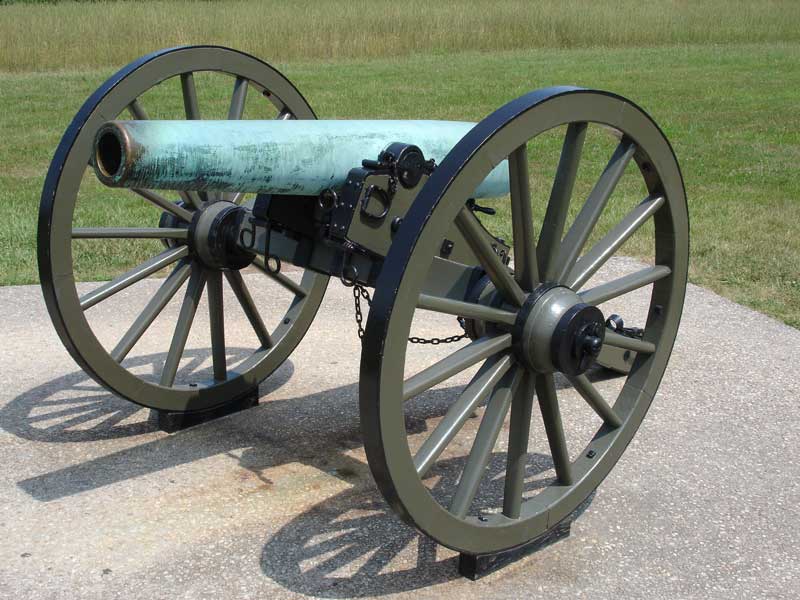Smoothbore Musket

Prior to the Civil War, the standard weapon of choice for infantrymen was the smoothbore musket. These guns would fire round balls out of barrels without any grooves inside of them. Due to their design, muskets were generally only accurate for short ranges. This characteristic determined military strategy for the time period, where infantry units were grouped together for maximum firepower. To do this, battles were often fought over open ground in columns. This in turn influenced the development of both artillery and cavalry tactics. For instance, cavalry units could only effectively maneuver over open ground, where they could use their superior speed to overtake enemy positions. And since smoothbore muskets were generally inaccurate at long ranges, cavalrymen could charge without the threat of such fire.
Minie Ball

But the development of a new type of Civil War gun and ammunition, rifled guns and the Minie Ball, changed the weapons used in the Civil War. With this new Civil War gun, bullets would rotate has they moved through the air, greatly increasing their accuracy. Now, infantrymen were far more accurate with their shots, greatly increasing their effectiveness.

Unfortunately for many of the soldiers at the time, military tactics were still in use based on the assumption of the old, smoothbore muskets and not the new weapons used during the Civil War. With these new Civil War weapons, there was a much greater value for defensive fortifications. Charging a defended position over open ground was essentially a suicide mission, especially if the other side was further protected by cannons. Perhaps most importantly, cavalry units became a lot less useful in this new military world. And as the war progressed, generals slowly but surely began to use their cavalry more for reconnaissance and supply duty than for actual battles.
 But it was a slow and painful process to adapt to the new weapons used during the Civil War. Time and
But it was a slow and painful process to adapt to the new weapons used during the Civil War. Time andHawkin Rifle

The amazing thing was that this was not the first time General Lee encountered such a situation. During the Seven Days Battle in 1862, the Confederate army was pushing the Union away from the capital of Richmond and towards the James River. Towards the end of the week, the South reached Malvern Hill, where the North had a powerful defensive position in order to protect the flank as they retreated towards the river. General Lee, seeing an opportunity to split the Union army in two, charged across the farm fields into the Union cannons and infantry equipped with a new Civil War gun. They were easily repulsed with much loss of life. Fortunately for Lee, Union General George McClellan did not press the advantage and continued to retreat. But despite this painful loss, General Lee apparently did not learn his lesson when he ordered that famous charge across the fields of southern Pennsylvania. It took him a long time to realize that the new weapons used during the Civil War required a new way of fighting, since these new Civil War weapons were best utilized in different capacities.
As the two sides slowly came to realize how unsuitable the old tactics were with the new weapons used during the Civil War, trench warfare became the standard tactic for protection from the enemy. Combined with the new Civil War weapons and cannons, frontal assaults became even more deadly. But by 1864, the Union was now led by General c. He was determined to use the North's numerical superiority to overwhelm the armies of Lee. And thus he continually attacked well-entrenched Confederate positions using the modern Civil War gun. He did achieve his goal of keeping the pressure on the South, but only at a tragic cost in lives lost. Perhaps the most devastating of these moments was at the battle of Cold Harbor, where an early morning assault on the morning of June 3 led to 7,000 Union casualties in less than a half-hour of fighting.
Napoleon 12-Pound gun

(In 1853, France introduced the Canon-obusier de 12, a 12-pounder capable of using either shells, shot or canisters. Napoleon cannon remained in service during the Victorian period seeing action in the American Civil War)
These casualties were further multiplied by the extensive use of cannons during the war. Although advances with cannons were not as far along as they were with the new Civil War gun, they were still extremely effective in countering frontal charges. Unlike the Civil War gun, most cannons used in the Civil War were still smoothbores, not rifled. The most popular of the Civil War artillery was definitely the Napoleon 12-Pound gun, named for the famous French general. These cannons could fire a variety of ammunition, depending upon the situation. Solid shot was a typical ammunition used to batter advancing enemy columns. Cannon shells, on the other hand, were exploding ordinance that was particularly effective against fortified units. But perhaps the most devastating of all artillery ammunition was the canister shot. This type of shell contained hundreds of miniature balls inside of it and could absolutely mow down advancing infantry units at close range. Artillery firing canister shells stopped many infantry charges during the Civil War.
There is no doubt that the weapons used during the Civil War, including the new Civil War gun and other Civil War weapons, led to a far more deadly type of warfare and a complete reevaluation of military tactics. The ultimate consequences was a civil war with 600,000 casualties and a country nearly torn apart in the process.








0 Comments:
Post a Comment
We appreciate comments, but we delete SPAM.